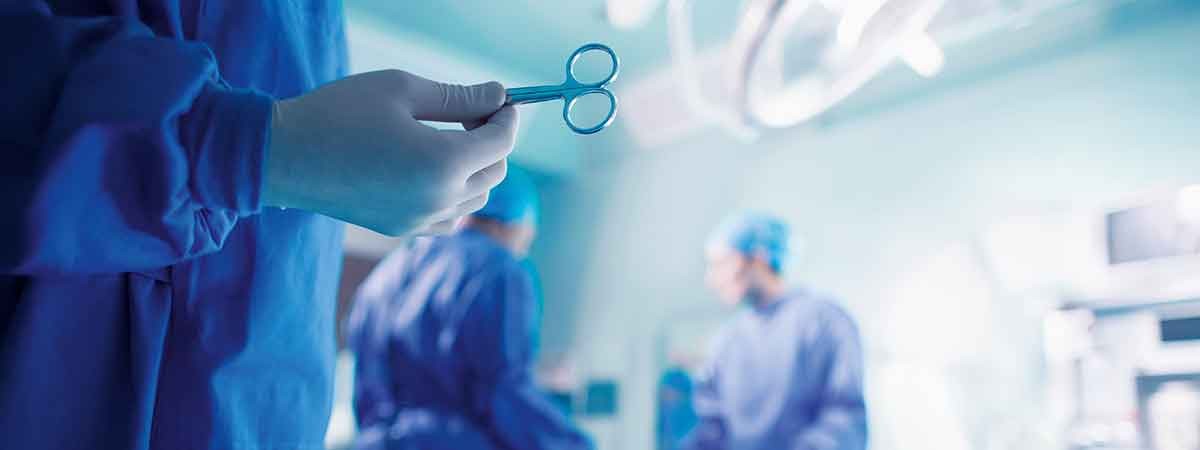With a low-pressure plasma, microorganisms can be effectively eliminated even at low temperatures. Plasma sterilisation in a vacuum therefore offers a quick and materials-friendly alternative to traditional methods such as sterilisation with hot water vapour.
Medical instruments need to be disinfected before use. In hospitals, this is widely performed using steam sterilisation under increased pressure in autoclaves. Alternatives to this are treatment with dry heat, toxic chemicals such as hydrogen peroxide, or ionising radiation.
Vacuum for cold plasma
Plasma sterilisation has been available for a few years and is an additional method that can be used to effectively neutralise pathogens. If the process is performed in a vacuum, it does not require high temperatures – just 60°C is sufficient to kill off the microorganisms. As a result, many heat-sensitive materials such as plastics or electrical components can be sterilised using this method. This is particularly useful for sensitive medical devices such as endoscopes, for example. Plasma sterilisation also offers additional advantages over traditional methods: it only takes a few minutes, making it significantly faster than thermal methods. In contrast to chemical treatment, it does not create any toxic or carcinogenic vapours or residues.
Sluggish ions
The plasma status – which is often referred to as the fourth state of aggregation – can be created from a gas or an air-gas mixture, by feeding energy into it. Depending on process temperature, a distinction is made between cold and hot plasmas.
When the plasma is ignited, the gas molecules degrade into ions and electrons. If all reaction parameters are caused to oscillate in this process, a high-energy, hot plasma is formed. In contrast, cold plasma is created by feeding in precisely the amount of energy needed to make only the tiny electrons move, and heat up to temperatures of a few thousand degrees. However, the heavy ions are not stimulated, and so remain cold. As these dominate the temperature due to their mass, the overall plasma stays at room temperature. A cold plasma can be created more easily in a vacuum, as the particles collide less frequently due to the reduced density.
Effective against pathogens
Cold plasmas with a temperature of approximately 60°C are used in plasma sterilisation. They are created in a vacuum, from gas mixtures containing argon combined with hydrogen, oxygen, or nitrogen. The object is placed in a process chamber, which is then evacuated. At low pressure, the process gas is then let in and converted into plasma using high-frequency microwaves. Charged particles, free radicals and UV-emitting photons are formed in the process.
The plasma achieves its sterilising function through several mechanisms: Intense UV radiation breaks down the genetic substance of the microorganisms; free radicals oxidise their cellular components; and ion bombardment ensures their mechanical destruction. The deadened material is simultaneously removed from the surface through the plasma's corrosive effect. The complexity of plasma sterilisation makes it very effective, and means that bacterial strains that are resistant to traditional methods can also be killed off. Furthermore, thermo-stable prions, the most well-known of which caused the bovine BSE epidemic, can be deactivated and removed using this approach.

Pathogen-free without heat
Vacuum enables plasma sterilisation to take place without subjecting it to high temperatures
Why is the infection risk in hospitals so high?
We are accompanied by microorganisms everywhere we go. A healthy person hosts more than 100 billion of them on and in their body. Most of the organisms are an important part of us, for example because they help in the digestion of food or train the immune system.
The infection risk in hospitals
However, there are also microbes that cause disease, and these can cause serious infections. It is therefore important to prevent them from entering the body. Particular caution is needed in hospitals, as additional portals of entry into the body become available to pathogenic bacteria in the course of treatment. For this reason, medical devices and instruments such as endoscopes or surgical kit are sterilised before use. In the ideal case, this process not only renders all bacteria, viruses and fungi harmless, but also does the same for their spores as well as infectious proteins, DNA, and pyrogens.
We are accompanied by microorganisms everywhere we go. A healthy person hosts more than 100 billion of them on and in their body. Most of the organisms are an important part of us, for example because they help in the digestion of food or train the immune system.
The infection risk in hospitals
However, there are also microbes that cause disease, and these can cause serious infections. It is therefore important to prevent them from entering the body. Particular caution is needed in hospitals, as additional portals of entry into the body become available to pathogenic bacteria in the course of treatment. For this reason, medical devices and instruments such as endoscopes or surgical kit are sterilised before use. In the ideal case, this process not only renders all bacteria, viruses and fungi harmless, but also does the same for their spores as well as infectious proteins, DNA, and pyrogens.